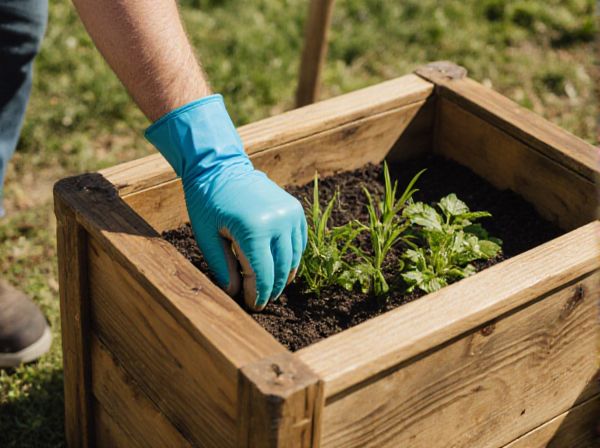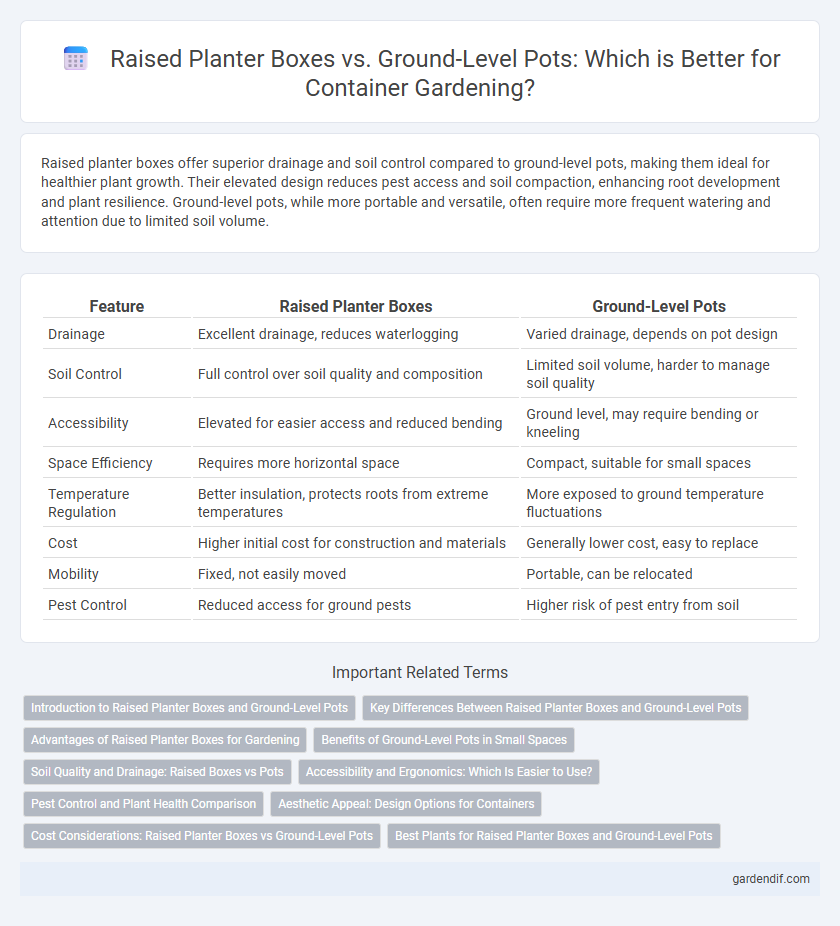
Raised planter boxes vs ground-level pots Illustration
Raised planter boxes offer superior drainage and soil control compared to ground-level pots, making them ideal for healthier plant growth. Their elevated design reduces pest access and soil compaction, enhancing root development and plant resilience. Ground-level pots, while more portable and versatile, often require more frequent watering and attention due to limited soil volume.
Table of Comparison
| Feature | Raised Planter Boxes | Ground-Level Pots |
|---|---|---|
| Drainage | Excellent drainage, reduces waterlogging | Varied drainage, depends on pot design |
| Soil Control | Full control over soil quality and composition | Limited soil volume, harder to manage soil quality |
| Accessibility | Elevated for easier access and reduced bending | Ground level, may require bending or kneeling |
| Space Efficiency | Requires more horizontal space | Compact, suitable for small spaces |
| Temperature Regulation | Better insulation, protects roots from extreme temperatures | More exposed to ground temperature fluctuations |
| Cost | Higher initial cost for construction and materials | Generally lower cost, easy to replace |
| Mobility | Fixed, not easily moved | Portable, can be relocated |
| Pest Control | Reduced access for ground pests | Higher risk of pest entry from soil |
Introduction to Raised Planter Boxes and Ground-Level Pots
Raised planter boxes elevate soil above ground level, improving drainage and root aeration while reducing soil compaction and pest exposure. Ground-level pots offer portability and flexibility in placement, making them ideal for small spaces and seasonal changes. Both options provide controlled environments for container gardening, with raised planter boxes supporting larger, deeper root systems and ground-level pots enabling easy relocation.
Key Differences Between Raised Planter Boxes and Ground-Level Pots
Raised planter boxes offer improved drainage and soil control compared to ground-level pots, reducing the risk of root rot and pests. They provide better accessibility and can increase soil temperature, promoting faster plant growth. Ground-level pots, however, are more portable and space-efficient, making them ideal for small patios and balconies.
Advantages of Raised Planter Boxes for Gardening
Raised planter boxes provide superior drainage and soil control compared to ground-level pots, promoting healthier root development and reducing the risk of waterlogging. They offer better protection from pests and weeds, minimizing maintenance and enhancing plant growth. Elevated design improves accessibility for gardeners, making planting and harvesting easier, especially for those with limited mobility.
Benefits of Ground-Level Pots in Small Spaces
Ground-level pots maximize limited small space by allowing flexible arrangement and easy mobility, enhancing plant diversity and access to sunlight. These containers also support better soil temperature regulation and moisture retention compared to raised planter boxes. Compact pots facilitate efficient watering and maintenance, making them ideal for urban balconies and patios.
Soil Quality and Drainage: Raised Boxes vs Pots
Raised planter boxes offer superior soil quality control compared to ground-level pots due to their ability to hold a larger, custom soil mix that promotes healthier root development and nutrient retention. Enhanced drainage in raised boxes reduces waterlogging risk, preventing root rot and fostering optimal oxygen flow to plants. In contrast, pots often restrict root expansion and require frequent drainage monitoring to avoid water accumulation and soil compaction.
Accessibility and Ergonomics: Which Is Easier to Use?
Raised planter boxes offer superior accessibility by elevating plants to a comfortable height, reducing strain on the back and knees, especially for individuals with limited mobility or arthritis. Ground-level pots require frequent bending and kneeling, which can be physically challenging and less ergonomic for extended gardening sessions. Elevated designs often include wide ledges for tools and seating, enhancing ease of use and overall gardening comfort.
Pest Control and Plant Health Comparison
Raised planter boxes offer improved pest control by elevating plants away from soil-dwelling insects and allowing better drainage to prevent root rot. Ground-level pots are more susceptible to common pests like slugs and soil-borne diseases due to direct contact with the ground and limited airflow. Enhanced airflow and soil temperature regulation in raised planter boxes promote stronger plant health and reduce the risk of fungal infections.
Aesthetic Appeal: Design Options for Containers
Raised planter boxes offer sleek, modern lines and can be customized with various materials like wood, metal, or composite, allowing seamless integration into contemporary garden designs. Ground-level pots come in diverse shapes, sizes, and colors, providing versatility for artistic arrangements and seasonal swaps that enhance visual interest. Both options enable strategic plant layering and texture contrast, boosting the overall aesthetic appeal of outdoor spaces.
Cost Considerations: Raised Planter Boxes vs Ground-Level Pots
Raised planter boxes generally involve higher upfront costs due to materials like cedar or composite wood, as well as optional features such as liners and irrigation systems, whereas ground-level pots are typically more affordable and require minimal setup. Maintenance expenses can vary, with raised planter boxes potentially reducing soil replacement and pest control costs over time, while ground-level pots might need more frequent adjustments and replacements. Budget-conscious gardeners should weigh initial investment against long-term durability and functionality when choosing between raised planter boxes and ground-level pots.
Best Plants for Raised Planter Boxes and Ground-Level Pots
Raised planter boxes thrive with deep-rooted vegetables like tomatoes, carrots, and peppers, benefiting from improved drainage and soil aeration. Ground-level pots suit compact herbs such as basil, thyme, and mint, offering better moisture retention and ease of access. Selecting plants according to container depth and soil conditions maximizes growth and yield in both gardening methods.
Raised planter boxes vs ground-level pots Infographic

 gardendif.com
gardendif.com